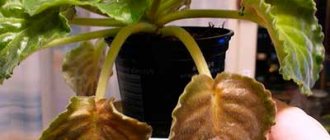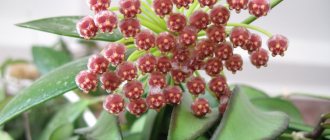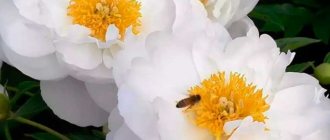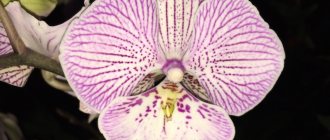Sapling bushes, a perennial herbaceous plant from the Asteraceae family, growing in European and Asian territories, northern America and the tropics of Africa, are decorative not only during long flowering. Throughout the season, they look original in the garden plot, on the lawn, in compositions with cereals, perennial crops, flowers, and perfectly decorate ponds. An unpretentious and hardy sable flower will attract attention both in single and group plantings.
Description and distinctive features
The appearance of the window sill depends on the species and variety. In the general description, one can identify features characteristic of most species. Under natural conditions, it is either a low (30 cm) or tall subshrub, up to 2 m high.
A distinctive feature is straight, weakly branching stems and petiolate oppositely attached leaves, which can be pinnate, palmate-lobed, lanceolate, or ovate. The edge of the plate is cut with small teeth. The color of the smooth or rough leaf is mainly dark shades of green; some species have pronounced burgundy veins and dark purple streaks.
In August, fragrant inflorescences appear, formed by small cream, white or purple flowers, collected in a small basket. Sometimes the width of the inflorescence reaches a quarter of a meter. The flower petals are round, the stamens are collected in a bunch. Flowering is abundant and long lasting until late autumn.
The scientific name (Eupatorium) of the flower was given in memory of Mithridates Eupator (Kingdom of Pontus), who used one of the varieties as an antidote. According to one version, the origin of the Russian name is associated with its similarity to the male hemp plant, which was colloquially called “poskon”.
Obesity treatment
For weight loss, it is recommended to use a tincture that normalizes digestive processes, activates metabolism, and burns fatty tissue. Correcting your diet will help increase the effectiveness of the product - while taking the home remedy, you will have to stop eating fatty foods and sweets. Step by step recipe:
- Pour sapling grass, previously turned into powder (you will need 10 grams of plant material), with red wine (500 ml).
- Infuse the product for three days, strain.
- Fill the glass bottle, seal, store in a cool place.
Take the tincture daily in the morning. Dosage – 50 ml. It is advisable to take the appointment after breakfast. Long-term treatment of obesity is not recommended - it is necessary to use the tincture in courses of two weeks.
Poskonnik - how to grow in open ground
You can grow saplings from rhizomes or stratified seeds. Stratification is simple - mix the seeds with wet sand, pour them into a glass container and place them in the vegetable section of the refrigerator for a month.
When purchasing a rhizome, you need to inspect it, paying attention to elasticity, density, absence of putrefactive spots and damage. If it is purchased in the spring, then it should have buds. The seedling of the finished seedling should have a dense stem and leaves, the roots should not stick out from the container (if they are visible, it means the seedling is overexposed and weakened). Be sure to inspect the rhizome and young plants for the presence of insects and fungal infections.
Sowing seedlings
You need to sow seeds in the ground in the first ten days of March, using ready-made soil for flower crops. The planting depth should be no more than 5 mm so as not to impede germination. Cover the container with cellophane (glass) and place in a warm, bright place, but not in direct sunlight. The greenhouse must be ventilated to remove condensation, moisten the soil without allowing the top layer to dry out.
Soak the seeds for 24 hours in a pink manganese solution.
After 2-3 weeks, shoots will appear; after that, remove the cover. When two pairs of leaves are formed, pick into separate containers. 10-12 days before planting in open ground, begin hardening by taking the seedlings outside and gradually increasing the time of the procedure. Purchased seedlings must also be hardened.
Selecting a location and planting in the ground
The culture is distinguished by its undemandingness to light - the window sapling grows well in sunny areas and in partial shade. It also blooms in the shade, but you need to keep in mind that the flowers and leaves will be smaller. There are also no special requirements for the composition of the soil, but on heavy soils it loses its decorative effect, so they can be lightened by adding sand and peat.
Seedlings are planted in a permanent place when the soil is warmed up and there is no threat of return frosts - in the 2nd-3rd decade of May.
Before planting seedlings, the area needs to be dug up; you can add 3-5 kg/1 m² of compost. Make holes at a distance of 60-80 cm from each other, their depth should correspond to the size of the root system. Water the plantings and cover them from the sun for several days so that rooting occurs faster and with the least stress for the plants.
Combination with other plants
This ornamental bush looks impressive in a mixborder, in a group planting with other shrubs; it can cover an unsightly building or be used as a hedge.
It goes well with large plants such as Rogersia, Volzhanka, and Astilbe.
Nearby you can plant bladderwort, mock orange, bushes of park roses or lilacs.
The majestic beauty of the window sill is emphasized by low decorative foliage plants, for example, hosta, heuchera.
When using a perennial in a flower garden, take into account its tallness, so plant it in the background.
A sapling bush will look very good if tall grasses, heleniums, rudbeckia, echinacea, and delphiniums are located nearby.
Considering the late appearance of shoots in the spring (approximately May), plant the place where the sapling grows with early primroses: crocuses, snowdrops, scylla or corydalis.
Then in early spring this piece of land will not look dull.
This culture is absolutely not aggressive and does not suppress nearby plants at all.
How to care
Caring for window sills in open ground is not difficult. Like any plant, it needs feeding, watering, weeding, loosening, pruning, and protection from insects. The crop is distinguished by its high growth, so you should provide for the installation of a support or plant the flower near a fence or buildings so that there are no through winds that could break the stems. The stems are not pruned, but in order to preserve decorativeness and prevent self-seeding, faded inflorescences are cut off.
The plant is cold-resistant, so there is no need to cover it for the winter - it is enough to cut off the above-ground part at the end of autumn.
Watering, fertilizing
As a moisture-loving crop, the flower needs to be watered regularly, depending on the weather conditions. It is important to prevent the soil from drying out and flooding. Loosening will eliminate the formation of crust on the surface and the growth of weeds. Mulch made from grass, leaves, hay will reduce moisture loss and inhibit the growth of weeds; crushed dry branches, small pebbles, pine cones, and decorative bark can be used to give a decorative look. Humus and compost as mulch will become a source of additional nutrition.
The choice of fertilizer for the sill is influenced by the period of its application. In the spring, when feeding for the first time, it is recommended to use complexes with a prevailing nitrogen content - it stimulates the growth of green mass, which is important for an ornamental plant. Watering with mullein infusion and adding humus to the soil gives a good effect.
They feed the second time in June, enriching the soil with macro- and microelements necessary for the formation of buds and abundant flowering. Complex fertilizers for flowering crops are suitable - they indicate the composition and exact dosage. You can add phosphorus, potassium, magnesium, nitrogen separately, following the instructions.
The next feeding is carried out during the budding period, using complexes with potassium: potassium salt, potassium sulfate, nitrate, potassium chloride.
Nitrogen is not needed during this period - the plant’s forces should be directed to the formation and development of buds, and nitrogen causes foliage to grow.
In mid-October, phosphorus-potassium complexes with a minimal content (or complete absence) of nitrogen are introduced to support the immunity of the perennial before the winter cold. They can be used dry or in solution. Humus and compost poured under each bush will protect the roots in frosts and replenish the soil with organic matter.
Pests, diseases
The culture has good immunity and is not susceptible to pests or infections. It can be harmed by the larvae of moths, insects, beetles - the so-called miners, which eat passages in the stems and leaves. Pruning the affected parts and treating the entire plant with an insecticide helps.
More details about window sill care in the video:
Application
The perennial not only decorates the garden, but also has practical value as a medicinal plant.
In the garden
- The sill is used to decorate walls, fences, and create high flower beds.
- The perennial looks good against the background of trees and shrubs.
- Can be used to create thick combinations. The plant looks interesting in a composition with tall ornamental grasses.
- Suitable for various types of gardens, including naturalistic ones.
- It will become an unusual decoration for ponds in the garden.
- Attracts butterflies and other insects.
It should be remembered that the plant grows quickly and can occupy a large area.
Good neighbor plants for the window sill:
- loosestrife,
- buzulnik,
- japanese anemone,
- tall ornamental grasses,
- sagebrush.
Reproduction methods
The saplings are propagated by divisions, shoots, and cuttings.
Delenkoy
You can get a division only from an adult (4-5 years old) plant in spring or early autumn. Planting in the spring will allow the flower to grow stronger before the onset of cold weather.
Before digging up the bush, the shoots are cut off, leaving “stumps” 20 cm high, and the soil is moistened. The rhizomes, freed from the ground, are divided (you can use a saw) into parts, the sections are treated with a fungicide and planted in a permanent place in holes prepared in advance.
There must be growth points (at least three) on the division.
By shoots
The use of shoots presupposes the presence of recovery buds. In the spring, when the shoots grow to 5 cm, they are cut out along with the rhizome. Each bud is planted in a separate cup or in a common container, maintaining an interval of 7 cm between them. The seedlings are placed in a warm, shaded place and watered moderately. After rooting, after about 4 weeks, they are transplanted into a flower bed.
Handle
Cuttings are carried out at the end of June, the length of the cuttings should be 10-15 cm, there should be three or more growth points. For rooting, they are planted in a damp mixture of peat and sand, covered with a jar (bag). Care consists of ventilating the greenhouse and moistening the soil. When strong roots appear, after about a month, they are planted in a permanent place.
If you follow the rules for planting and caring for the window sill in the open ground, you can grow a strong, healthy plant with excellent decorative qualities. The perennial will decorate the local area, flower bed, garden plot, lawn, requiring a minimum of attention in return.
Treatment of skin diseases, ulcers, wounds, burns
Due to its wound-healing property, it is recommended to use a rich infusion of saplings at home for the treatment of diseases of the dermis, for severe burns, ulcers, and violations of the integrity of the skin.
A home remedy will relieve inflammation, stop the spread of the lesion, and activate healing. Preparation:
- Combine roots and sapling grass (20 grams each).
- Combine water (200 ml), herbal ingredients.
- Place the container on low heat, and after boiling, simmer for 20 minutes.
- Remove and leave to cool.
After filtering, the product is used for compresses. Soak a bandage or gauze cloth in the heated liquid and place it on the affected area of the dermis. Fix and leave for 2 hours.
Repeat the procedure daily, be sure to monitor the reaction of the skin. With increased sensitivity, irritation and rashes may appear.
Itching, discomfort, and unpleasant burning are also signals to immediately stop the procedures and resort to another wound-healing medicine offered by alternative medicine.
Requirements for the care of the window sill
The plant does not put forward any special care requirements.
The sapling needs timely feeding, hydration and help with pest attacks.
The window sill can grow to a considerable height, so it needs support. This plant is often planted near the walls of fences, gazebos or verandas. If the bush grows separately, its position can be strengthened with a stake.
The herbaceous plant does not need pruning. Only occasionally should it be used to remove damaged branches. Also, many gardeners remove wilted inflorescences to prevent the spread of saplings by self-sowing.
Advice!
By the way, plants grown as a result of self-seeding can be used for propagation, selecting large individuals and destroying small and unnecessary ones.
The window sill is endowed with frost resistance, which allows it to survive in winter without special shelter. The main thing is to cut off the ground part in the fall, leaving a small fragment of the trunk above the ground level.
As soon as spring warmth sets in, friendly shoots appear from the soil. If there are a lot of these shoots, then it is worth thinning out the extra ones, leaving the strongest ones.
9.Healing properties
In folk medicine, all parts of the plant are used - leaves, roots and inflorescences. Sapwood is used as an anti-inflammatory, diaphoretic, expectorant, analgesic, wound-healing, and laxative.
Various ointments, tinctures and decoctions are prepared based on the extracts of this shrub.
↑ Up,
There are also some contraindications when using sapwood for medical purposes. Since all parts of the plant are poisonous, extreme caution must be taken and taken under the supervision of doctors. It is prohibited to give plant-based products to children under 18 years of age.
↑ Up,
Popular varieties
Purple sapling - planting and care
There are 4 popular varieties of flowers, often used to decorate garden plots.
Spotted
The country of origin of the species is North America. The plant prefers to grow in meadows, forests, thickets and coastal areas. Spotted sapwood is represented by several varieties:
- Album. Reaches 2 m in height, distinguished by white inflorescences with a slight grayish tint;
- Atropurpereum. Bright red stems grow up to 2 m, the flowers have a pink-violet color. The variety is popular in gardening;
- Big Amrelaz. It is distinguished by grayish-pinkish flowers located on red shoots. The bush grows up to 1.8 m;
- Bortherd Bride. 40 cm higher than other representatives. Snow-white flowers are evenly distributed on the stems;
- Baby Joe is a spreading bush up to 2 m in height with dark green foliage and different shades of flowers: from snow-white to blue;
- Gateway. The size does not exceed 1.5 m. The dome-shaped inflorescences are pink-purple in color, the stems are red;
- Caryn. Grows up to 2 m. Flowers are light lavender in color;
- Purple Bash does not outgrow 1.5 m. The variety has smaller flowers than Gateway, with a similar mauve color;
- Phantom. A little more than 1 m in height. The stems are dark in color, the flowers are bluish-lilac.
Poskonnik Phantom
For your information! An adult bush of this species reaches a height of 1.8 m and has elongated leaves.
Purple
Distributed in North American lands, reaches a height of 1.5 m. The stems have a greenish-bluish color, and small fibers can be seen on the foliage. Large inflorescences are formed from small baskets. The colors are varied: from pinkish to lilac-purple.
The Little Red variety has gained particular popularity. The height of the bushes does not exceed 1 m, the inflorescences have a wine-pink color. Little Joe, the second most common variety, has flowers a smoky pink.
Hemp
Distributed in European countries, grows near streams, rivers, and swampy areas. Gardeners in landscape design use several varieties:
- Album. Identified by white flowers;
- Variegatum is a low-growing variety (up to 0.75 m) with deep pink flowers, a white line on the edge of the foliage;
- Plenum. It is distinguished by a height of 1.6 m, a long flowering period, and the formation of terry baskets.
The average height of the bush ranges from 0.2 to 1 m. The foliage has small teeth on the edge, the inflorescences have a pinkish color.
Wrinkly
Bushes with oval leaves, opposite arrangement, with a carved edge along the edge. The following varieties are especially favored by gardeners:
- Breinlaub is up to 1.5 m in size. Young leaves have a brown color;
- Chocolate. It has good frost resistance, white flowers, bronze-brown glossy foliage with a slight purple tint.
Poskonnik Chocolate
Basic conditions for growth
To grow saplings, you need to create certain conditions. In its natural environment, it grows along the banks of water bodies, in wet meadows, and along the edges of wet forests. It can also be found in thickets and ditches.
A similar environment must be provided at the artificial planting site. The plant loves fertile, moist but well-drained soil. It’s great if it’s soil with a calcareous slope, but light sandy soil is also suitable. The earth can be neutral, slightly acidic or slightly alkaline.
Some species do not tolerate cold, and some winter well in the middle zone. The plant does well in partial shade. In the bright sun, its shoots dry out and wither.
Often gardeners do not understand how to water the window sill. It requires abundant moisture in dry soils or moderate watering in naturally moist soils. The plant looks better with regular fertilization. Fertilizing is applied monthly from spring to autumn.
Complex mineral compositions are used. In the early growing season, fertilizers with nitrogen are useful; from mid-summer, for better flowering, it is advisable to limit this element.











